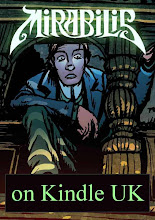There’s a tendency among many writers of literary
fiction to opt for emotional coolness and ironic detachment, as though fearing
that any hint of excitement in their storytelling would undermine the serious
intent of the work. I don’t know where this notion came from. You can’t see
Maugham or Greene or Forster having any truck with it. But the question is not
where it started but whether that is the kind of literary writer that Kazuo Ishiguro
is.
Adam Mars-Jones seems to think so. In his LRB review of The Buried
Giant, he particularly takes Ishiguro to task for throwing away what
ought to be a Fairbanks-style set-piece in a burning tower by allowing “nothing
as vulgar as direct narration to give it the vitality of something that might
be happening in front of our eyes”.
I’m not so sure about that particular scene. It could
be that Ishiguro is reaching, not for the drama of the events, but the drama of
the telling of the events. In the way he deploys the scene, we’re left in the
dark for a while as to the fate that has befallen a major character. It’s how
Conrad, say, might have chosen to tell it. The point is, though those events
are not told in a way that plays up the excitement of the action itself, they nonetheless
have dramatic effect. It works – just not as Mars-Jones or I might have
preferred.
But there are other bits of the story that do not work
at all, and make me think that Ishiguro either scorns, or is not craftsman
enough to manage, the control of the reader’s expectations that is needed for a
novelist to hold and enthral.
An example – and from here on beware of spoilers:
Wistan and Sir Gawain are both supposedly charged with killing a dragon whose
breath is causing people’s memories to slip away. Finally, approaching the
dragon’s lair, Sir Gawain reveals that he has actually been protecting it for
all these years. The two warriors walk up to the lair, chatting away, and we
have plenty of time to see how this has to play out. Wistan and Gawain must
fight, and because the book has a good way to go yet and there’d be no story if
the dragon isn’t killed, we can see that Wistan will beat Gawain, and then
he’ll slay the dragon. Almost sheepishly, Ishiguro then goes through those
exact motions, apparently sensing that something he has done has defanged what
ought to be a thrilling peripety, but not knowing how to fix it.
Unlike the burning tower, this isn’t a case of a scene
that Ishiguro has made to work differently. As he tells it, the scene simply
does not
work. No story can grip if it fails to make the reader wonder what’s going to
happen next. Here’s how he could have fixed it. Wistan and Gawain walk up to
the lair. Wistan is still injured from the fight in the tower, Gawain is an old
man. We wonder if even together they’ll be able to overcome the dragon. Then,
just as they’re about to descend into the crater where the dragon waits,
Gawain steps in front of Wistan and admits that he is sworn to protect it. Now
that would be a moment of pure anagnorisis to make Aristotle cheer – and the
reader would be left reeling. What? Sir Gawain’s on the dragon’s side? He’s
about to fight Wistan? What is going to happen now?
See? Told like that we wouldn’t have time to predict
the consequences. We’d be in the moment, struggling to draw breath. It would be
– gosh – exciting. And it would work.
There are other places where Ishiguro struggles with
the storyteller’s craft like it’s a broken deckchair. Fleeing from enemy
soldiers through an underground labyrinth, Gawain and his companions come to a
portcullis, which they lower – barring their own escape route – simply so that
they can discuss (ie tell us about) the hell-hound that is said to dwell in the
tunnels. In a movie the hound would at least turn out to be on the same side of
the portcullis, though the shock would be soured by knowing the characters had
done something dumb just for the sake of getting the plot into its next
mooring. As it is, the hound turns up on the other side and we have to go
through a lot of tedious mechanics about how they will raise the portcullis while
ensuring that the hound doesn’t attack the two old people who are tasked with
doing that. Everything plays out exactly as Ishiguro has just had his
characters describe it, and then to top it all off we have to go through yet
more nuts-n-bolts prose about getting the portcullis up having cut the rope
earlier.
This verges on “he crossed the room, putting one foot
in front of the other, until he reached the other side,” and it’s surely the
job of the editor to point out to the poor dumb author that he has befuddled
himself with foolish details and really ought to take a stab at getting the
story firing on all cylinders rather than wandering around the side alleys of
his narrative in an obsessive-compulsive daze.
Talking of obsessive-compulsive, I feel compelled to
dwell on some quibbles. Ishiguro has a curiously imprecise control of authorial
viewpoint that may possibly be deliberate, but in light of some of the fumbled
set-pieces I’m inclined to think it’s just a failure of craft. For instance,
lapsing into a personal narrative voice as he is inclined to do every hundred
pages or so, he says, “Many were roundhouses not so far removed from the kind
in which some of you, or perhaps your parents, were brought up.” Ah, so I am
supposed to be a reader familiar with this world; these are events that
occurred just a generation or two back. But not so fast – just a few lines
further on he describes “a tall fence of tethered timber poles, their points
sharpened like giant pencils” and we’re back in a modern mindset. Why not, “and
a duckpond the shape of an iPad,” while you’re at it, Kazuo?
Maybe that skittering viewpoint is deliberate, but how
about the sinews from a hacked-off arm being described as “entrails”? A
“hollowed-out trunk” – when he means just a hollow trunk. “Comprised of” occurs
a couple of times; didn’t this book have an editor? And there are several
instances of constructions like, “with my wife and I hanging together on the
rope” – these from characters whose grammar is otherwise solid enough.
And then this: the narrator tells us, “This door – it
would have been a ‘proper’ door on wooden hinges – ” What? That voice, that “it
would have been”, is how I might relate an anecdote. Pyrrhus being hit by the
roof tile, for instance; something I know about but have no first-hand
knowledge of, so I have to intuit details like, “it would have been a
flowerpot-shaped cylindrical tile.” But everything else in The Buried Giant is related as if
the narrator is there to see breath steaming on a cold morning, clothing
flapping in a high wind. So why that one lapse into a removed viewpoint? If
it’s technique rather than carelessness, it’s a technique that fails to have
any useful effect.
Tom Holland in The Guardian gives Ishiguro the benefit of the doubt. "The gaps and seams," he says, "[...] are designed to show." But I say, goddamn
it, an author should do the bloody work. Nabokov wanted Laura burned, and it was in not greatly more ramshackle a state than The Buried Giant.
And yet – the book has something. A world in which
memory is unreliable, a fantasy told without the pomp-rock bombast that’s
typical of the genre, events recombining in oddly shifted permutations as in a
dream, a quasi-allegorical exploration of love and loss – those are all interesting ideas. And Ishiguro has moments of great
inventiveness that are well-served by his flatly unadorned style, as he talks
of the ogres that emerge out of the mist or describes an attack by pixies on a
boat caught in reeds. It often reads (and this probably is deliberate) like a translation of a classic saga, in
that its brilliantly arresting images are recounted in the voice of an academic whose
striving for accuracy sacrifices any of the original’s lyrical power. Fine, that's what Ishiguro set out to do and that, at least, he achieved. But me, I like to luxuriate in the poetry of beautiful language, and I kept thinking that if my
accountant rewrote Malory or Beowulf she might end up with something a lot like this.
Look, here's the thing. All this carping is because I can see the outline of something great here. I just
wish Ishiguro had chipped away the stone until he found it. Written by somebody like Alan Garner, The Buried Giant
would be fabulous. As it is, throughout the book we continually run smack into
quagmires of clumsy prose and expository specifics , with the result that it all
reads like the extensive notes an author prepares before he or she gets stuck
into writing the novel itself. It really is half brilliant and half incompetent
– both "fascinating and moving" and yet "aimless and atomized", as Laura Miller described it in Salon - and that alone makes it almost unique among modern novels. Well, I say that,
but I have yet to read the rest of Mr Ishiguro’s oeuvre.
If I haven't put you off reading the book (and I hope I haven't) then you might be interested in hearing Kazuo Ishiguro talk about it on this Guardian podcast.
























